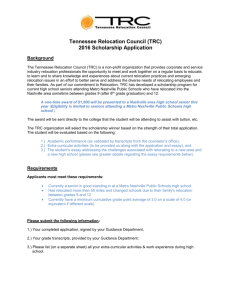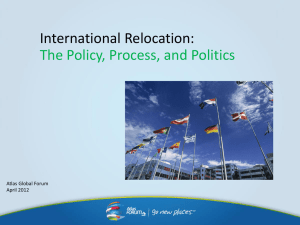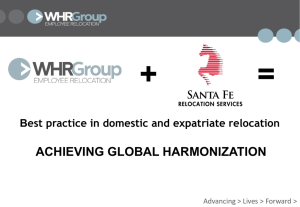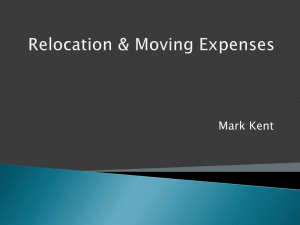Preparing for Disaster-Induced Relocation
advertisement
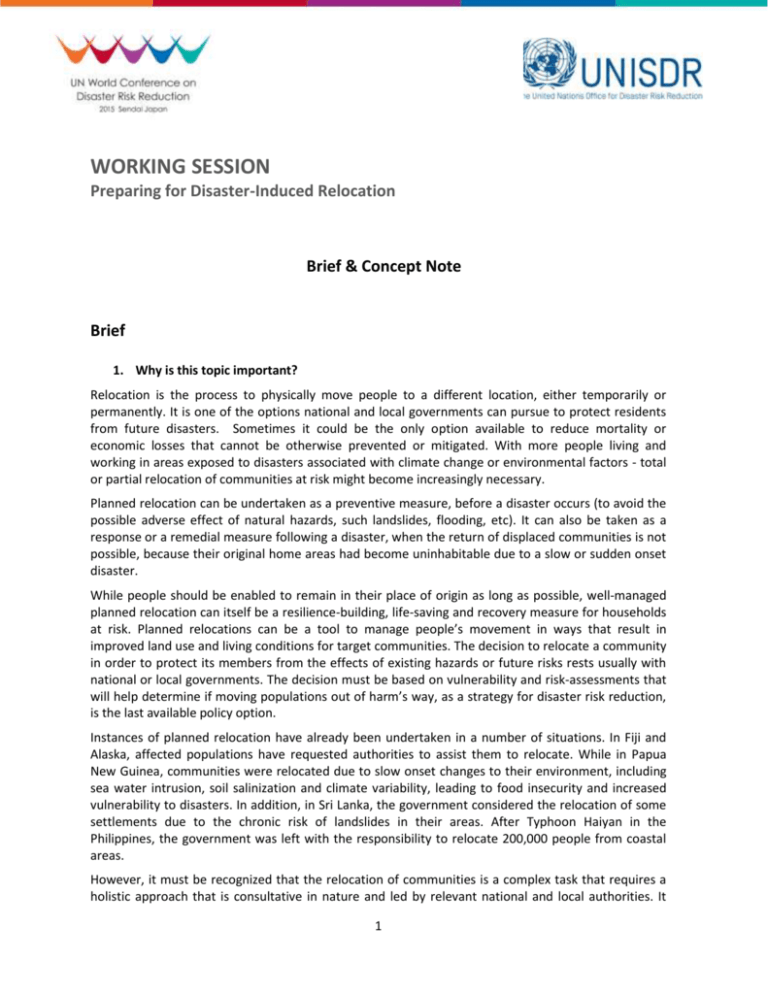
WORKING SESSION Preparing for Disaster-Induced Relocation Brief & Concept Note Brief 1. Why is this topic important? Relocation is the process to physically move people to a different location, either temporarily or permanently. It is one of the options national and local governments can pursue to protect residents from future disasters. Sometimes it could be the only option available to reduce mortality or economic losses that cannot be otherwise prevented or mitigated. With more people living and working in areas exposed to disasters associated with climate change or environmental factors - total or partial relocation of communities at risk might become increasingly necessary. Planned relocation can be undertaken as a preventive measure, before a disaster occurs (to avoid the possible adverse effect of natural hazards, such landslides, flooding, etc). It can also be taken as a response or a remedial measure following a disaster, when the return of displaced communities is not possible, because their original home areas had become uninhabitable due to a slow or sudden onset disaster. While people should be enabled to remain in their place of origin as long as possible, well-managed planned relocation can itself be a resilience-building, life-saving and recovery measure for households at risk. Planned relocations can be a tool to manage people’s movement in ways that result in improved land use and living conditions for target communities. The decision to relocate a community in order to protect its members from the effects of existing hazards or future risks rests usually with national or local governments. The decision must be based on vulnerability and risk-assessments that will help determine if moving populations out of harm’s way, as a strategy for disaster risk reduction, is the last available policy option. Instances of planned relocation have already been undertaken in a number of situations. In Fiji and Alaska, affected populations have requested authorities to assist them to relocate. While in Papua New Guinea, communities were relocated due to slow onset changes to their environment, including sea water intrusion, soil salinization and climate variability, leading to food insecurity and increased vulnerability to disasters. In addition, in Sri Lanka, the government considered the relocation of some settlements due to the chronic risk of landslides in their areas. After Typhoon Haiyan in the Philippines, the government was left with the responsibility to relocate 200,000 people from coastal areas. However, it must be recognized that the relocation of communities is a complex task that requires a holistic approach that is consultative in nature and led by relevant national and local authorities. It 1 should only take place as a last resort after all options have been exhausted. It is important to ensure that states and supporting actors undertake relocation in a manner that respects the human rights of affected populations. Obtaining the free and informed consent of affected communities (both relocating and host communities) requires their consultation and participation in the planning and decision making process of relocation. At the international and regional level, disaster risk management practitioners engaged in human mobility such as through management of planned relocation, migration and displacement need to come together with national authorities to ensure that planned relocation efforts are integrated into strategies related to disaster risk reduction strategies and climate change adaptation efforts. International stakeholder should especially work to facilitate identification and dissemination of best practices, guidelines and methodologies for successful relocation 2. What gaps need to be filled? Relocations are costly and complex processes that have the potential to reduce people’s access to livelihoods, disrupt their social networks and engender a variety of land and property challenges, thereby causing impoverishment and further vulnerability to affected communities. As a consequence, there are examples of relocations that have failed to sustainably reduce a population’s risk. Such cases are illustrated by people refusing to relocate or returning to the area of origin after relocation. While in other cases, new groups have settled in the vacated areas. To address these challenges, the session will provide examples on how planned relocation considerations can be incorporated within DRR strategies in a manner that would respect human rights, reduce hazard exposure, manage environmental pressures and strengthen people’s resilience. The session will also provide information on existing guidelines, principles, international standards, methodologies, lessons learned and conventions etc, which can inform relocation processes (both preemptive and remedial). It will propose specific suggestions to strengthen their applicability (nationally or across borders), with a view to sustainably reducing risk and finding durable solutions for those involved in the relocation. For example, the session will be informed by probabilistic estimates of disaster-related displacement risk—and analysis of its drivers—in order to consider the best ways to address it through informed planned relocation and other means of reducing and managing disaster risks. Approaches to managing population movements in disaster situations, including by addressing associated land and property challenges will also be explored. Finally, the session will highlight the importance of adopting a multi-stakeholder approach to mainstreaming planned relocation. 3. What (new) commitments will be achieved? While planned relocation can be effective to reduce the exposure of vulnerable populations and assets to disasters, it must be an option of last resort. Recognizing this, the session will explore how the management of planned relocation can support the implementation of apost-2015 disaster risk reduction framework. It will highlight how well managed relocations can help reduce the impacts of natural hazards, prevent the creation of new conditions of vulnerability and strengthen the resilience of people and communities. More specifically, the session will seek actions and commitments by: Providing an overview of the challenges and complexities of planned relocation in the context of disasters; Sharing lessons learned and good practices of planned relocation; Outlining the key legal and operational tools, including probabilistic displacement risk models and decision-support tools, available to facilitate the implementation of planned relocation; 2 Reflecting on the importance of international cooperation and multi-stakeholder partnerships to address planned relocation in an inclusive manner, such as through the development of joint or integrated policies and planning on related issues (e.g. climate change, development, humanitarian, protection of displaced persons, human rights, and migration management). 3 Concept Note Schedule Monday 16 March, 2015. 14:00-15:30 Room and Venue Hagi Hall, Sendai International Conference Center (tbc) Organizers IOM, Nansen Initiative, NRC, RAED, UNHCR, UNISDR UNISDR Focal Points Amjad Abbashar (abbashar@un.org) Background and Rationale In 2013, over 22 million people were displaced from their homes by disasters associated with natural hazards. Droughts, floods, earthquakes, as well as climate change, environmental degradation and technological disasters induced by natural hazards force millions of people to move within their own countries and across international borders. The above figure does not include all types of disaster situations, including under-reported smaller, frequent events. Furthermore, disaster-related displacement also commonly occurs in the context of conflict situations, where, in many cases, natural and man-made hazards combine as complex drivers of vulnerability and crisis. In the future, it is expected that vulnerable people and assets will increasingly concentrate in high risk areas, particularly in urban locations that may suffer from the effects of climate change and environmental degradation. With climate change predicted to increase, the frequency and intensity of hydro-meteorological and other climaterelated hazards may increase, leading to more disaster induced population flows, including planned relocations. While the HFA provided some limited recognition to displacement as a potential factor that could increase vulnerability, it did not sufficiently address the growing challenge of managing planned relocation as a possible risk reduction and resilience building measure. Since more and more people live in regions and locations highly vulnerable to disasters and other impacts of climate change, national and local authorities may have to increasingly use planned relocation as one of the options in their toolbox to protect populations at risk. Adequate management of planned relocations will be essential to the achievement of the objectives of apost-2015 disaster risk reduction framework. In the design of relocation programmes, governments and concerned stakeholders need to ensure that due attention is paid to current and future high-risk areas in order to reduce exposure and identify vulnerable groups. In this regard, disaster risk management efforts should also aim to anticipate the particular protection and assistance needs of vulnerable groups. Furthermore, potential vulnerabilities that could stem from the relocation operation should be addressed by ensuring that people being relocated enjoy adequate access to 4 livelihoods, social services and infrastructure that are essential for resilience. Potential conflict between relocated and host communities over scarce resources and opportunities should also be anticipated and prevented. One proven way to address this is by ensuring that target communities are actively engaged, consulted and empowered to participate in the planning and decision making process through inclusive policies. Session Objectives Outline the gaps and challenges of planned relocation in the context of disasters. Underline how best to carry out and/or improve planned relocation processes based on lessons learned and good practices. Clarify the roles and responsibilities of national and local governments as well as affected communities engaged and/or affected by relocation. Discussion agenda and structure 1. 2. Opening by Chair – Setting the scene (7 minutes) Keynote address – Institutional challenges of relocation (7 minutes) Panel discussion: 3. Overview of planned relocation challenges – Policy and strategic overview (7 minutes) Practical examples: 4. 5. 6. 7. 8. Expected outcomes Lessons of planned relocation – Case 1 (7 minutes) Lessons of planned relocation – Case 2 (7 Minutes) Lessons of planned relocation - Case 3 (7 Minutes) Open Discussion – (Estimated 40 Minutes) Closing remarks – Recommendations and commitments (7 Minutes) Recommendations to partners on how best to identify instances for potential planned relocation Strengthened understanding on how best to undertake preventative or remedial planned relocation in disaster contexts, where appropriate. Provide recommendations on how to enhance and clarify responsibilities, coordination and leadership at all levels to ensure that planned relocation is effectively carried out with due respect to the rights of the affected population. Commitment / special T announcement in support of a post-2015 framework for DRR Expected number of 150 5 participants Background documents - - - Mass evacuation in natural disasters guidelines (thematic modules forthcoming): http://www.globalcccmcluster.org/tools-andguidance/publications/mend-guide Land and property guidelines for shelter actors: https://www.sheltercluster.org/References/Pages/HousingLand-and-Property.aspx Compendium of IOM activities on DRR and resilience (includes thematic guidance notes on planned and post-disaster relocations, participatory approaches and other relevant issues). http://www.iom.int/files/live/sites/iom/files/What-WeDo/docs/IOM-DRR-Compendium-2013-partI-II.pdf World Bank guidelines on relocation: http://www.gfdrr.org/sites/gfdrr.org/files/Chapter_5_To_Reloc ate_or_Not_to_Relocate.pdf IFC resettlement handbook: http://www.ifc.org/wps/wcm/connect/22ad720048855b25880 cda6a6515bb18/ResettlementHandbook.PDF?MOD=AJPERES Final Report Planned Relocation, Disasters and Climate Change: Consolidating Good Practices and Preparing for the Future, 2014 http://www.unhcr.org/54082cc69.html Background document, Planned Relocation, Disasters and Climate Change: Consolidating Good Practices and Preparing for the Future, 2014 , http://www.unhcr.org/53c4d6f99.html UNHCR Temporary Protection or Stay Arrangements, 2014 http://www.unhcr.org/542e99fd9.html 6
